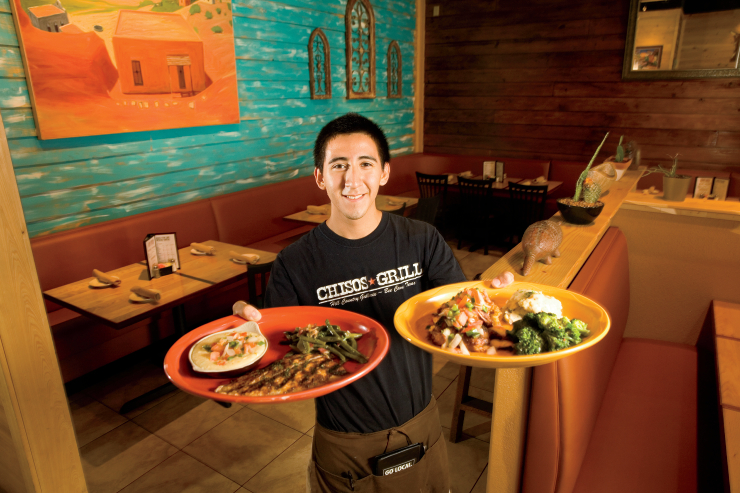Home > Texas > Texas Farm to Table > Local Food is the Secret Ingredient for Texas Chefs
Local Food is the Secret Ingredient for Texas Chefs
In partnership with: Texas Department of Agriculture

The local food movement has taken hold in Texas, especially in Austin, and it’s expanding rapidly to Houston, Dallas and even into the more rural areas of the state.
“We used to think of sourcing food locally as a trend, but now it has become the norm,” says Wendy Womack, coordinator for marketing for the Texas Department of Agriculture, which promotes Texas food and beverage products through its GO TEXAN program. “Good chefs have always focused on cooking what’s in season, but now they are focusing on sourcing food from their farming neighbors.”
GO TEXAN member Chad Jones is chef and co-owner of Chisos Grill in Bee Cave, just outside of Austin. Jones is one chef who has made locally-sourced food the centerpiece of his menu.
“We make a conscious effort to source our menu ingredients locally,” Jones says. “That philosophy stems from our belief that locally-farmed products will lead to fresher, higher quality food served to our customers.”
A lifelong resident of Texas, Jones has been in the restaurant business for almost 20 years. He says sourcing food locally, with the help of the GO TEXAN program, is the right choice for his customers, his community and Texas businesses.
Local Foods First
“At the end of the day, outsourcing products based on cost means you lose quality and freshness, and those things are priceless,” he says. “It’s a noticeable difference. When we use fresh, properly raised produce and meat, it makes a real difference in what’s on the plate. Sourcing locally also allows us to focus on natural products. We don’t use any processed foods in our restaurant, and we make everything from scratch.” Jones first looks for food products ranched or farmed within a 20-mile radius of his restaurant.
“We get our quail from Lockhart, our tomatoes from Marfa and our beef from Rockdale,” he says. “With a menu of about 85 items, unfortunately, we can’t get everything right here; but for me, local means as close as I can get it. The Gulf Coast of Texas is as close as I can get seafood, with 80 percent of what we serve coming from that region, including wild-caught Gulf shrimp, redfish and oysters.”
For those foods Texas doesn’t produce, Jones uses local food distribution companies as providers. “We are committed to supporting local businesses,” he says.

Local Beverages, Too
At Chisos Grill, more than the food has a Texas address.
“Texas is a very large producer of wine, beer and spirits,” Jones says. “Ninety percent of our bar items are sourced from inside the state.”
Chisos’ Ghost Bar offers 30 beers, 25 spirits and 20 wines produced in-state. In fact, Womack just partnered with Jones to organize wine, beer and spirits tastings at Chisos Grill to celebrate the 2013 GO TEXAN Restaurant Round-Up week. Together, they contacted and scheduled a different GO TEXAN wine, beer and spirit member to visit the restaurant each day for that week.
Womack says locally-produced craft beers and wines continue to be a growth market. Meats, including cured products and specialty items, also are gaining in popularity.
“Chefs are showing interest in sourcing whole animals,” Womack says. “We’ve also seen an increase in demand for local lamb and goat. For example, GO TEXAN recently helped a rancher who wanted help sourcing up to 10 lambs to local restaurants each month. We were able to help link that producer to chefs looking for his product.”

A Growing Trend
Locally-sourced food is moving beyond restaurant kitchens and into the marketplace.
“We’ve noticed the focus on local food is trending in retail as well,” Womack says. “Even stores are interested in having local products on their shelves. Texas retailers are making an effort to offer Texas products, and that’s good news for our producers.”
The demand for local food fits into a global world, according to Womack.
“As the world becomes more global, people are looking to reconnect to their local communities in a hyper-local way. The fact that we’re so globally connected makes us want stronger local connections, and food meets that need.”



